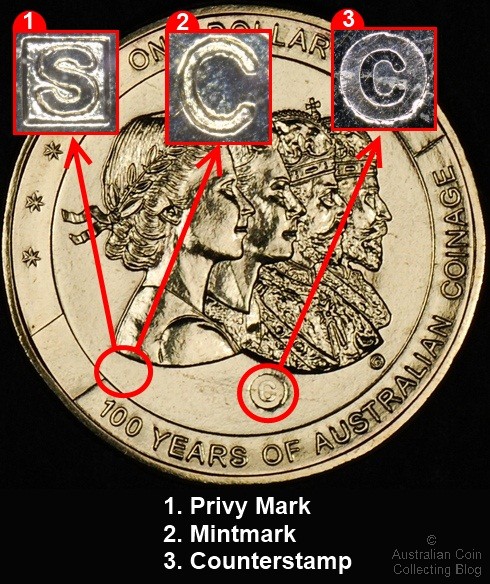
2010 Centenary of Decimal Coinage One Dollar
The Australian circulating one dollar coin is a popular issue among collectors. Along with the well known mob of roos reverse design the one dollar has seen many commemorative issues released into circulation. Moving into the collector market we have seen numerous non-circulating dollar designs of the same size, weight and composition as the normal circulation issues.
Each year a particular NCLT (non-circulating legal tender) design is chosen to be the mintmark coin for that year. This is the coin design that will display various marks such as mintmarks, privy marks and counterstamps.
But what is the difference between these marks? In 2008 after the Royal Australian Mint made it clear to collectors what the new marks represented and how they would be used on coins, we wrote a blog post entitled Mintmarks, Privymarks and Counterstamps. What is the difference?. Prior to 2008 a single mintmark (this mark prior to 2008 actually looked like what we now call a counterstamp) was used and it was difficult to determine at which location or by which method a coin was struck, thus the need for a change.
Sadly, in 2009 the CEO of the RAM, Janine Murphy (who appears to have been the driving force behind the new scheme) became unwell and the use of the portable press at coins shows ceased until late 2010. After a new permanent CEO, Mr Ross MacDiarmid, was appointed in 2010 we saw the portable press appear in November at the Canberra ANDA coin show and now it's due for the first ever trip of the portable press to Perth in February. Now in 2011 with the release of the 4 coin ram's head dollar set, we thought it was worthwhile visiting the topic again. We've done this a lot more visually this time and the 3 different types of marks can be seen in the above image.
1. The Privy Mark.
This is an incuse letter within a square surround struck in relief. The letter represents a location but does not imply the coin was struck at that location. For example, S for Sydney.
2. The Mintmark.
This is an unaccompanied letter struck onto the coin. The letter is on the die when the coin is struck and denotes the location that the coin is struck. The mintmark is a raised letter with no surround ie. C mintmark struck at the Gallery Presses or production presses at the RAM in Canberra, ACT.
3. The Counterstamp.
The counterstamp is a raised letter within an incuse circular surround. Coins are brought to the location pre-struck with the design and the mobile coin press strikes the circle with the accompanying letter onto the coin ie. C for Canberra. The counterstamp seen above was stamped on the portable RAM press at the Canberra ANDA Coin Show in 2010.
If you're interested in what mintmarked, counterstamped, and privymarked coins have been released since 2008 then please take a look at our Complete Guide to Australian One Dollar Coins which includes links the releases for each year where you can see the mintage figures for each coin as well as links to articles on the individual coin designs.
Posted by harrisk at January 21, 2011 7:31 PM
Subscribe to our Newsletter


